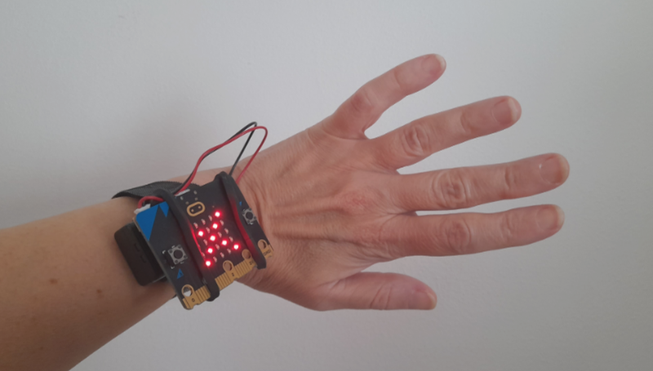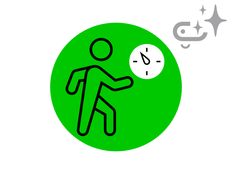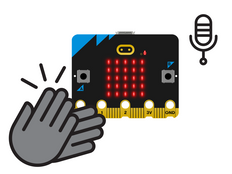Make an AI light switch with micro:bit CreateAI that makes a light turn on when you clap and turn off when you wave.
Step-by-step project guide
Step 1: Understand it
How does it work?
In this project, you’ll train a machine learning (ML) model to recognise when you’re clapping and waving.
You’ll combine that model with a MakeCode program that sends a ‘lightsOn’ radio signal to another micro:bit whenever you clap, and a ‘lightsOff’ radio signal whenever you wave.
When the receiver micro:bit receives the ‘lightsOn’ signal, all its LEDs light up. When it receives the ‘lightsOff’ signal, it clears its LED display.
What is machine learning?
Machine learning (ML) is a kind of artificial intelligence (AI) where computers can learn from and make decisions based on data.
ML models are trained by humans to help them make those decisions, for example, to recognise different ‘actions’ when you move your micro:bit in different ways.
What will I need to do?
AI systems need humans to design, build, test and use them. You'll collect data to train an ML model, test it, improve it, and combine it with computer code to make a smart device that uses AI. You'll use a micro:bit and the micro:bit CreateAI website to do this.
Step 2: Create it
What you need
- Two micro:bit V2s, USB cable, one or two battery packs
- A computer (e.g. desktop, laptop, or Chromebook) with access to the micro:bit CreateAI website, using a Chrome or Edge web browser
- If your computer does not have Bluetooth enabled, you’ll need an extra micro:bit V2
- A strap and holder, or another way to attach the micro:bit to you (e.g. flexible craft stems or elastic bands)
- You may also find our micro:bit CreateAI teaching tips useful
Collect data samples
When you open the project in micro:bit CreateAI, you’ll see we’ve given you some data samples for ‘waving’, 'clapping’ and ‘still’ actions:
waving
clapping
still
You can add your own movement samples using the micro:bit's movement sensor or accelerometer.
In micro:bit CreateAI, click the 'Connect' button to connect your data collection micro:bit and follow the instructions.

Attach the micro:bit to your wrist. Click on the first action, ‘waving’, and click 'Record'. If you make a mistake, you can delete any samples you don’t want. You can also press button B on the micro:bit to start recording.
If you would like to record continuously for 10 seconds to get 10 samples, click on the three dots next to the record button and select that option.
Now record your own data samples for the ‘clapping’ and 'still' actions, making sure for 'still' that you collect samples in different positions, such as facing up and down.
Train and test the model
Click the ‘Train model’ button to train the model. Try clapping, waving and keeping still to see if those actions are estimated. Give your micro:bit to someone else to wear (making sure they put it on the same wrist and in the same orientation) and see if it works as well for them.
Improve your model
Most models can be improved with more data. If the model needs improving, click on ‘← Edit data samples’.
You can delete any data samples which you think don’t fit or add more samples.
Train the model again, and test it again.
Put the model and code on your micro:bit
In micro:bit CreateAI, click on ‘Edit in MakeCode’ to see the project code in the MakeCode editor.
You can modify the code or just try it out as it is. Attach the first micro:bit using a USB cable, click on the ‘Download’ button in the MakeCode screen, and follow the instructions to transfer your AI model and the code blocks to it. Afterwards, download again onto another micro:bit.
Attach a battery pack to the sender micro:bit. You can keep the receiver micro:bit plugged into the computer or attach it to battery pack. Now wear the sender micro:bit and test it out.
How the code blocks work
When the program starts, the radio group is set to 52. Radio groups are like channels, so any micro:bit using the same group will get the message. You can use any group number you like from 0-255. If you are using this project in a class or coding club, you might like to encourage each pair or group of students to use a different radio group from others in the class.
The 'on ML... start' blocks are triggered when the sender micro:bit’s ML model decides you have started waving, clapping or being still.
If you are clapping, the ‘on ML clapping start’ block causes a tick icon to appear on the LED display of the sender micro:bit and the radio message ‘lightsOn’ to be sent to the receiver micro:bit. If you are waving, the ‘on ML waving start block’ causes a cross icon to appear on the LED display of the sender micro:bit and the radio message ‘lightsOff’ to be sent to the receiver micro:bit.
If you are still or the sender micro:bit can’t recognise your movements, the LED display is cleared and no radio message is sent.
The ’on radio received’ blocks turn on all the LEDs on the receiver micro:bit if a message is received saying ‘lightsOn’ and clear the screen if a message is received saying ‘lightsOff’.
The ‘on radio received lightsOn / lightsOff’ blocks are from a MakeCode extension called ‘Radio broadcast’. If you want to code this project yourself, you can find the blocks by clicking on ‘Extensions’ then choosing ‘Radio broadcast’.
Evaluation
How accurate is the light switch in turning on and off in response to your movements? How could you improve it, if needed?
How useful would this device be in real life? How does it compare to a regular light switch?
Step 3: Extend it
- You could light up a room by putting the same code on multiple micro:bits. Keep the other micro:bits still while someone moves another to turn them all on or off.
- Add a fourth action which causes the receiver micro:bit to show dimmed lights. Use the ‘set brightness’ block, found in the LED section under ‘More’.
This content is published under a Creative Commons Attribution-ShareAlike 4.0 International (CC BY-SA 4.0) licence.


